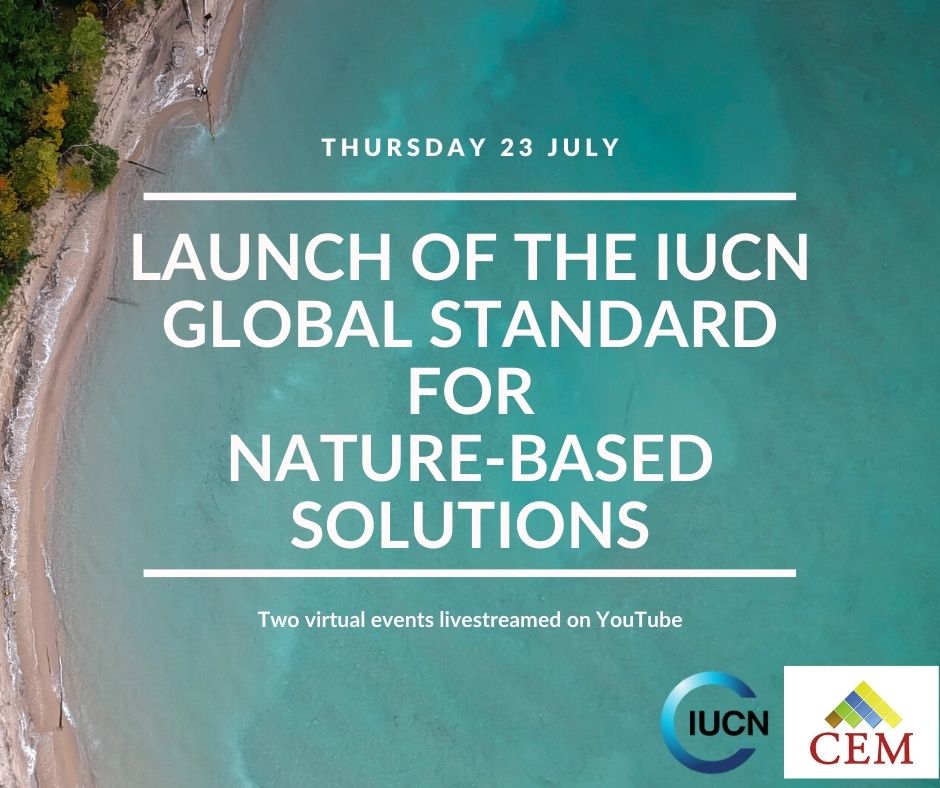IUCN Global Standard for NbS

Photo: IUCN
On Thursday 23 July, IUCN launched the first-ever Global Standard for Nature-based Solutions. Click here to download the document in English, French and Spanish and here for the press release.
In two high-level virtual events, stakeholders around the world joined leaders and champions of NbS from the private and public sector, to find out more about what is being done worldwide and what can be done with the Standard, to mainstream Nature-based Solutions and redefine our relationship with nature.
The two events were as follows:
Setting the standard
Nature-based solutions (NbS) are a powerful ally to address societal challenges such as climate change, biodiversity loss and food security. As the world strives to emerge from the current pandemic and move towards the UN Sustainable Development Goals, we need to ensure that future investments in nature reach their potential by contributing to the health and well-being of people and the planet. To this end, and with growing interest by governments and businesses to adopt and apply NbS, the first-ever IUCN Global Standard for Nature-based Solutions was developed to guide users through NbS applications and set benchmarks for their progress.
At the 2016 World Conservation Congress and members’ assembly, IUCN's members adopted a resolution (WCC-2016-Res-069) which, for the first time, defined the use of nature for simultaneous benefits to biodiversity and human well-being. According to the resolution, the definition of Nature-based Solutions is:
actions to protect, sustainably manage and restore natural or modified ecosystems that address societal challenges effectively and adaptively, simultaneously providing human well-being and biodiversity benefits”.
This definition is drawn from a more elaborated IUCN publication that outlines the Nature-based Solutions framework (Cohen-Shacham, 2016) and has been used to identify a set of eight best practice principles. Further research by IUCN identified the core principles for successfully implementing and upscaling Nature-based Solutions (Cohen-Shacham, 2019).
Now, with the IUCN Global Standard for Nature-based Solutions, there are clear parameters defining Nature-based Solutions and a common framework from which to work. Such a framework is essential to increase the scale and impact of the Nature-based Solutions approach, to prevent unanticipated negative outcomes or misuse, and help funding agencies, policy makers and other stakeholders assess the effectiveness of interventions.
The Global Standard for Nature-based Solutions enables everyone to consistently and reliably design, verify and scale-up NbS. –IUCN NbS Group
Why we need a standard
Increased demand for Nature-based Solutions has led to cases of misuse of the Nature-based Solutions concept, where even good intentions can result in harm to nature and people. In the worst-case scenarios, misuse runs the risk of damaging biodiversity, eroding the nature that we depend upon for services such as clean water and food.
For example, a tree-planting project using just one non-native species could result in poor soil biodiversity, ultimately making it more costly or impossible to sustain a diverse forest in the future. Similarly, restoring a mangrove forest to reduce the risk of storm damage could be doomed from the start if upstream and downstream processes are not considered. Lack of water use considerations in certain projects could lead to too much withdrawal, creating pressure on local communities. Failure to take into account social and economic factors like these has meant that even seemingly successful pilot applications of Nature-based Solutions have ultimately not been sustainable. Worse, weak or mislabeled Nature-based Solutions projects can water down the case for the Nature-based Solutions approach – de-incentivising its use, eroding donor confidence and misdirecting efforts.
Funders, investors and decision makers need to be confident that the Nature-based Solutions initiatives they support are effective and scalable, and consider potential externalities. Yet many may lack the resources or expertise to analyse and evaluate Nature-based Solutions projects. The standard helps to fill this gap.
What the standard is
Through public consultation reaching hundreds of stakeholders from 100 countries, the Global Standard for Nature-based Solutions was developed to be facilitative, incentivising and enabling users to implement strong Nature-based Solutions.
The IUCN Global Standard for Nature-based Solutions is a self assessment that consists of eight criteria and associated indicators, which address the pillars of sustainable development (biodiversity, economy and society) and resilient project management. The document itself is made up of the Standard and the associated guidance which will instruct users how to perform a self-assessment to:
- Design new Nature-based Solutions;
- Upscale pilots by identifying gaps and;
- Verify past projects and future proposals.
The output comes in the form of a percentage match compared against good practices, with a traffic light system to identify areas for further work and adherence to the IUCN Global Standard for Nature-based Solutions. The governing body of the IUCN Global Standard will be responsible for revising the criteria every four years, enabling improvement and incentivising engagement with the Nature-based Solutions approach across sectors.
Who will use it
Governments, companies, NGOs and others can use the standard, user guide and self-assessment tool to consistently design effective Nature-based Solutions projects that are ambitious in scale and sustainability, creating a shared language for stakeholders and facilitating innovative partnerships.
Donors and financers can invest in Nature-based Solutions with the standard as a benchmark, minimising risks and providing increased security. All user groups across the public and private sectors can also further engage with the governance structure of the standard, which connects stakeholders worldwide and ensures via feedback that the standard is used for its full potential to mainstream Nature-based Solutions.
In the past years, the EU has been one of the main driving forces in mobilising investment and creating partnerships for action to implement Nature-based Solutions across Europe, through the Horizon 2020 programme for Research and Innovation.
We hope that the Nature-based Solutions standard will be a useful tool to ensure the successful implementation of the various elements of the EU Green Deal, including the Biodiversity Strategy, Farm to Fork Strategy, Circular Economy Action Plan, and others. We envision that the standard will be helpful in developing and mainstreaming Nature-based Solutions in a greener Common Agricultural Policy - Luc Bas, Director of IUCN Europe.
What is next for the Global Standard for NbS?
The successful global consultation and launch of the first version of the Global Standard for NbS is just the first step on this journey.
There are still opportunities to get involved. Users are encouraged to:
- Pilot the Global Standard for NbS in current and future applications;
- and engage with the governance structure of the Global Standard for NbS (register your interest here).
To learn more, do not hesitate to get in touch with the IUCN NbS Group by emailing NbSstandard@iucn.org.
Original text provided by IUCN Global



